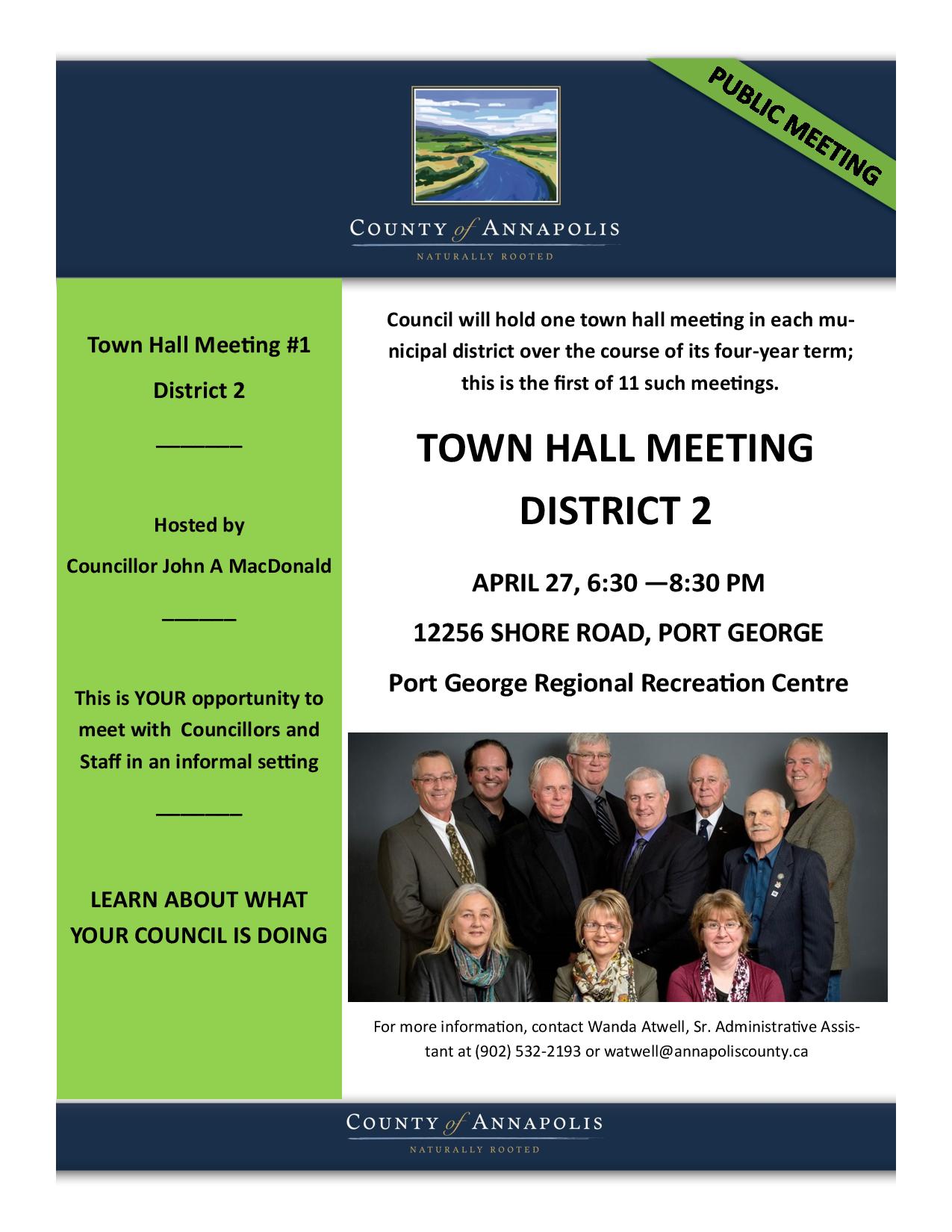News
Transfer facility keeps waste moving out of Annapolis County
Father and son team help ramp up and run West Paradise garbage, recyclables, compost operation
By Lawrence Powell
For Annapolis County
WEST PARADISE, NS – Steam rises from the loader bucket as Malcolm Francis moves compost from a pile in the corner to a roll-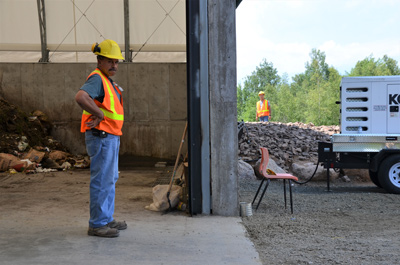 Malcolm Francis, left, stands near the grates were leachate from compost drains into a pipe. Marvin Francis is outside standing atop the large tanks that collect the liquid. They work at the West Paradise Transfer Station owned by Annapolis County. LAWRENCE POWELL PHOTOoff
Malcolm Francis, left, stands near the grates were leachate from compost drains into a pipe. Marvin Francis is outside standing atop the large tanks that collect the liquid. They work at the West Paradise Transfer Station owned by Annapolis County. LAWRENCE POWELL PHOTOoff 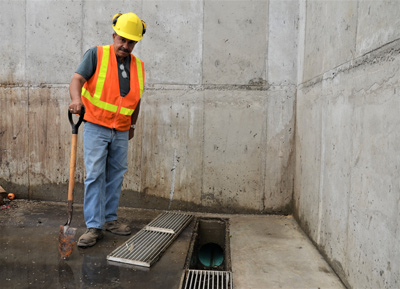 Malcolm Francis lifts up a grate where leachate from compost runs into a pipe that then goes into giant holding tanks. There is very little leachate and Malcolm expects the tanks might need to be pumped out a couple times a year. He manages the West Paradise Transfer Station that has been operating for several months now. LAWRENCE POWELL PHOTOcontainer that will be hauled away to a facility in Aylesford.
Malcolm Francis lifts up a grate where leachate from compost runs into a pipe that then goes into giant holding tanks. There is very little leachate and Malcolm expects the tanks might need to be pumped out a couple times a year. He manages the West Paradise Transfer Station that has been operating for several months now. LAWRENCE POWELL PHOTOcontainer that will be hauled away to a facility in Aylesford.
The truck driver scrapes a shovel across the smooth concrete floor to get the last bits before hauling the container back onto the vehicle. He rolls out the long black tarp to cover the load and heads east.
“The warmer the weather gets the more leachate you’ll get,” Malcolm said. “The compost is starting to work, as it’s supposed to, which creates a lot of liquids.”
He notes that the building’s floor is slanted just right for those liquids to collect at the grates, and every morning any leachate still on the floor from overnight is sprayed into the pipe and the tanks.
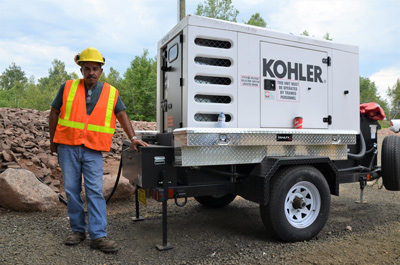 Malcolm Francis stands beside the generator that supplies power to the West Paradise Transfer Station owned by Annapolis County. Although poles are in place, Nova Scotia Power has yet to connect the facility to the electrical grid. LAWRENCE POWELL PHOTOIt’s late July during a heatwave. It’s 27C but the big doors are open and a breeze blows through the facility. They use a generator to provide electricity to open those doors. Power poles are in the ground, but the facility hasn’t been connected to the grid by Nova Scotia Power.
Malcolm Francis stands beside the generator that supplies power to the West Paradise Transfer Station owned by Annapolis County. Although poles are in place, Nova Scotia Power has yet to connect the facility to the electrical grid. LAWRENCE POWELL PHOTOIt’s late July during a heatwave. It’s 27C but the big doors are open and a breeze blows through the facility. They use a generator to provide electricity to open those doors. Power poles are in the ground, but the facility hasn’t been connected to the grid by Nova Scotia Power.
EXPERIENCE
Malcolm Francis knows what he’s doing. He’s been in waste management going back decades. He maneuvers the loader with deft touches in tight quarters. He backs it into a corner just as another truck arrives to drop off garbage and bags of recyclables such as bottles and cans, plastics, and paper and cardboard.
This operation? Malcolm wants people to know that it’s not a dump. It’s a waste transfer facility where bagged garbage, recyclables, and compost are dropped off by contracted haulers, loaded into bigger trucks, and taken away. There is nothing buried on the site and nothing remains on the site for more than a day or two.
“We have a lot of confidence in the ability and experience of both Malcolm and Marvin and we wouldn’t have been able to get to this point today without their expertise,” said Annapolis County Warden Timothy Habinski. “We managed to get the operation up and running very efficiently in a remarkably short period of time because of their help.”
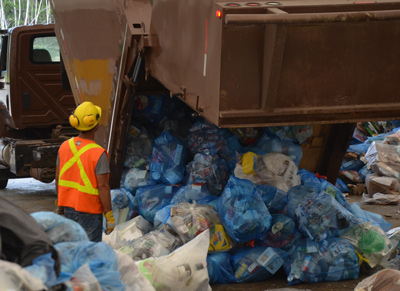 Marvin Francis watches as a truck unloads recyclables at the West Paradise Transfer Station. The facility handles bagged garbage, recyclables, and compost. Most of the waste is only in the building for a short time – sometimes only hours – before it’s shipped out for proper disposal. LAWRENCE POWELL PHOTOMarvin is Malcolm’s son, also with many years of waste management experience in Annapolis County.
Marvin Francis watches as a truck unloads recyclables at the West Paradise Transfer Station. The facility handles bagged garbage, recyclables, and compost. Most of the waste is only in the building for a short time – sometimes only hours – before it’s shipped out for proper disposal. LAWRENCE POWELL PHOTOMarvin is Malcolm’s son, also with many years of waste management experience in Annapolis County.
The site was selected by the county in part because it was already in operation as a construction and debris site without any difficulty and without any complaints.
“That use was not posing any difficulty for the neighbours,” said Habinski, adding there is only one home within sight line of the entrance and even that is quite a considerable distance from the facility itself.
“We took all those things into account in selection of the site,” he said.
“I think it’s a great building,” said Malcolm. “So far we have the room to look after the materials we have coming in. They’re not in here for long. They’re basically in and out, sometimes in the same day. So there’s nothing here very long.”
NO ODOR
There’s hardly any odor from the compost or the piles of bags and there’s not apt to be because they won’t be there for long. There’s a trailer from an 18-wheeler parked across the back of the building in a sunken bay where Malcolm will dump load after load of recyclables before day’s end. Paper and cardboard. The driver will be there at 6 a.m. sharp to haul it away.
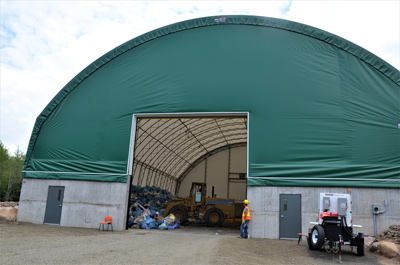 The West Paradise Transfer Station has been in operation for several months in Annapolis County. The fabric-covered building is a stop-off for garbage, recyclables, and compost before it is loaded on to larger vehicles and shipped out of county. LAWRENCE POWELL PHOTOMalcolm leaves Marvin to direct the latest truck into the drop-off area so it can unload the various waste streams in separate piles. The elder Francis is ready with the loader to push everything into the appropriate bigger piles against the concrete wall of the large building. It’s a scene they repeat several times throughout the day at the Municipality of the County of Annapolis’ West Paradise Transfer Station.
The West Paradise Transfer Station has been in operation for several months in Annapolis County. The fabric-covered building is a stop-off for garbage, recyclables, and compost before it is loaded on to larger vehicles and shipped out of county. LAWRENCE POWELL PHOTOMalcolm leaves Marvin to direct the latest truck into the drop-off area so it can unload the various waste streams in separate piles. The elder Francis is ready with the loader to push everything into the appropriate bigger piles against the concrete wall of the large building. It’s a scene they repeat several times throughout the day at the Municipality of the County of Annapolis’ West Paradise Transfer Station.
“I started with Annapolis County back in, I think it was ’86, out at the old Graywood incinerator,” Malcolm said. “I was there as lead hand supervisor up until October 4 of ’99 when we moved on to Valley Waste. And I was with Valley Waste under the same title until 2016.”
Malcolm was dismissed by Valley Waste but went to the labour board and later received a settlement for an undisclosed amount.
Marvin has been in waste management since 2006, having also worked for Valley Waste.
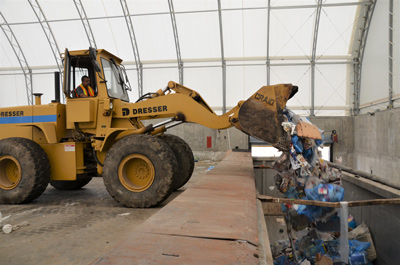 Malcolm Francis loads paper and cardboard recyclable material into the trailer of an 18-wheeler at the West Paradise Transfer Station. It’s late in the day, and the truck driver will pick up the trailer at 6 a.m. and haul the contents out of the county. LAWRENCE POWELL PHOTOHe uses hand signals to direct the big trucks as they back into the building. It’s a choreography he and the drivers have performed countless times. Four trucks twice a day.
Malcolm Francis loads paper and cardboard recyclable material into the trailer of an 18-wheeler at the West Paradise Transfer Station. It’s late in the day, and the truck driver will pick up the trailer at 6 a.m. and haul the contents out of the county. LAWRENCE POWELL PHOTOHe uses hand signals to direct the big trucks as they back into the building. It’s a choreography he and the drivers have performed countless times. Four trucks twice a day.
GOOD LOCATION
Malcolm said the location of the transfer station is good. It’s well away from Button Brook and there are no other water features on the property that he’s aware of. “It’s well away from the main road. It’s well away from home owners. To be quite honest I can’t see anything wrong with the site that they picked.”
The fabric-covered building is situated in a small bowl almost a kilometre above Highway 201.
Albert Rice owned and operated the property as a construction debris business for several years prior to selling the land to the County but is currently in control of the site. The County has a contractual agreement with him. But both Malcolm and Marvin are county employees.
Rice said that contrary to what some people may believe, there are no hazardous wastes entering the facility – household or industrial – unlike other sites in the county.
“There’s nothing that can come out of that building that can hurt the environment,” Rice said in reference to fears that leachate would escape into the soil. He said that’s a moot point anyway with the leachate collection system in place and the fact the organics will eventually be ground up, composted, and spread on farmers’ fields.
REGULATIONS AND TRAINING
Marvin said they follow all regulations required to operate such a facility.
“We’re also doing some safety training to get our courses back up to standard,” Malcolm said. “Being off, in my case, for four years most of mine had expired. But I’m back on track now renewing them. Marvin as well. We’re all doing online courses as we speak. These are courses that you need to work in an environment like this. And not just your WHMIS (Workplace Hazardous Materials Information System) and first aid training. I mean personal protection equipment training, lockout/tagout, transportation of dangerous goods. The list goes on.”
THE TRUCKS
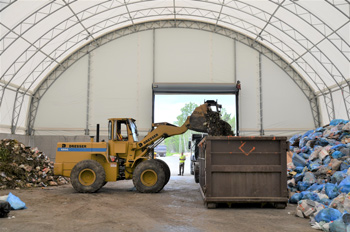 Malcolm Francis loads compost onto a roll-off container while the truck driver waits. The day’s-worth of table scraps, yard waste, and other organics will be taken to Aylesford for proper composting. LAWRENCE POWELL PHOTO“Per day, we have four regular curb-side trucks hauling into us. Those trucks, for the most part, would make two trips per day,” Malcolm said. “The odd time it would be three trips per day. We have a roll-off that comes in about every other day.”
Malcolm Francis loads compost onto a roll-off container while the truck driver waits. The day’s-worth of table scraps, yard waste, and other organics will be taken to Aylesford for proper composting. LAWRENCE POWELL PHOTO“Per day, we have four regular curb-side trucks hauling into us. Those trucks, for the most part, would make two trips per day,” Malcolm said. “The odd time it would be three trips per day. We have a roll-off that comes in about every other day.”
There’s also the roll-off container for compost every other day, plus the 18-wheeler that transports garbage to a landfill and hauls away the County’s recyclables, cardboard/paper, and bluebag plastics. Malcom said with the low weights they contend with, it would be ridiculous to think trucks in and out of the West Paradise Transfer Station are a threat to Highway 201.
As for the site itself, there’s not a scrap of litter outside the building; the grounds are surrounded by berms; and it’s set among trees almost a kilometer from Highway 201.
CARBON FOOTPRINT
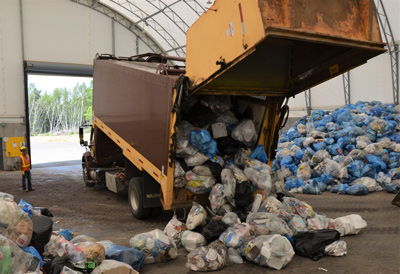 Clearbag garbage is one of the waste streams that come in to the West Paradise Transfer Station. Contracted haulers drop off the various streams which are then loaded onto larger trucks and taken out of county. LAWRENCE POWELL PHOTO“The biggest difference that we attained in our operation from having a transfer facility is the significant reduction in our carbon footprint as a municipality,” Habinski said. “On the mail out that we sent to residents we presented the figures for carbon when we’re running right from curb all the way to the actual landfills for the three streams of (waste) versus using a transfer facility. The carbon emissions drop by 80 per cent or more. And that’s always been a real concern for the municipality – even with the initial compost contract Valley Waste had, switching it from Aylesford to Colchester added 1,300 metric tons of carbon waste annually just from the one change of the contract. So we’re taking waste a much shorter distance and now we’re taking it as efficiently as we can from start point to finish point in order to reduce that carbon footprint as much as possible.”
Clearbag garbage is one of the waste streams that come in to the West Paradise Transfer Station. Contracted haulers drop off the various streams which are then loaded onto larger trucks and taken out of county. LAWRENCE POWELL PHOTO“The biggest difference that we attained in our operation from having a transfer facility is the significant reduction in our carbon footprint as a municipality,” Habinski said. “On the mail out that we sent to residents we presented the figures for carbon when we’re running right from curb all the way to the actual landfills for the three streams of (waste) versus using a transfer facility. The carbon emissions drop by 80 per cent or more. And that’s always been a real concern for the municipality – even with the initial compost contract Valley Waste had, switching it from Aylesford to Colchester added 1,300 metric tons of carbon waste annually just from the one change of the contract. So we’re taking waste a much shorter distance and now we’re taking it as efficiently as we can from start point to finish point in order to reduce that carbon footprint as much as possible.”
He thinks that something Annapolis County residents should be proud of.
“Even though we’re a small municipality, we have a joint obligation with the rest of humanity to reduce our carbon production to slow global warming,” he said. “This is one of the steps a municipality both can, and absolutely should, be taking. We should be taking this into consideration in many of our decisions. Having this transfer facility functioning is one of the ways we accomplish that.”
TRANSCRIPT FROM NOVEMBER 4, 2020 COUNCIL MEETING
ANNAPOLIS COUNTY CAO JOHN FERGUSON GIVES MUNICIPAL COUNCIL A CHRONOLOGY OF EVENTS LEADING UP TO PRESENT DAY REGARDING THE GORDONSTOUN NOVA SCOTIA PROJECT
The evolution of Gordonstoun Nova Scotia
I wanted to start, really, how this all came together, so people can get a general idea of how this evolved and where it is now. Originally, it was about five years ago Edward Farren contacted me. He was contacting me about the Annapolis Royal, the ARRA building, in Annapolis Royal, and he was curious what they were doing with the school. At that time, as people know, that they were looking at doing condominiums in the ARRA building and I told him that’s really I think what they’re doing but if he wanted to contact them then he could. He said ‘no, fine,’ then I let him go.
Probably a year later, I think it was, he contacted me again and he asked how they were doing with the project, and I had basically conveyed to him that it’s gone well. The condominiums are almost sold out and it’s turned into a successful project. And I asked him why. He said, no, he was working on something. And I said, well there’s another school in the county, it’s in Bridgetown, and it’s going to be torn down but you might be interested in that. He wanted to see a couple of pictures of it. I sent him a couple of photographs. And what I didn’t know at the time, and what it would mean to him, is that the Bridgetown school has round corners and a square section in the middle of the building. What he said after he saw the building was the Gordonstoun concept was the Round Square Movement. And so the building had an initial interest to him because of the round/square aspect of the building.
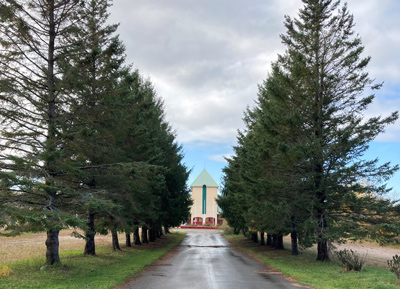 The entrance to the Former Upper Clements Park is the future location of one of the Gordonstoun Nova Scotia buildings. That building will be owned by Annapolis County. LAWRENCE POWELLSo then he began to tell us a little bit more about what he was intending to do, and he was looking to do a private school development. He wanted to use an old facility and bring it up. And then he wanted to meet with Gordonstoun about their ethos and talk to them about that. He asked myself and Timothy (Habinski) if we would go to Scotland. We went back to council. They okayed the greenlight to go, so we went over. We were also at the High Commission office in London related to recruitment of international students and some discussions that were held there. But ultimately the discussion at Gordonstoun went very well. It was at that time that they reached out to Ed and asked him if he would consider being the franchise. So he was excited about that.
The entrance to the Former Upper Clements Park is the future location of one of the Gordonstoun Nova Scotia buildings. That building will be owned by Annapolis County. LAWRENCE POWELLSo then he began to tell us a little bit more about what he was intending to do, and he was looking to do a private school development. He wanted to use an old facility and bring it up. And then he wanted to meet with Gordonstoun about their ethos and talk to them about that. He asked myself and Timothy (Habinski) if we would go to Scotland. We went back to council. They okayed the greenlight to go, so we went over. We were also at the High Commission office in London related to recruitment of international students and some discussions that were held there. But ultimately the discussion at Gordonstoun went very well. It was at that time that they reached out to Ed and asked him if he would consider being the franchise. So he was excited about that.
We came back and we followed up with Premier (Stephen) McNeil. Actually we met up with Premier McNeil before we went the first time back in 2017. We met in Bridgetown and at that particular discussion the Premier was interested in the project, communicated that there was a policy about guarantees, but wanted to hear more about the project. So when we got back the Premier was asked by Mr. Farren if he would go to Gordonstoun Scotland, so on the second trip it was Warden Habinski and Councillor (Alex) Morrison, the Premier. They went and they met and I guess really had really good discussions about what this could mean and how this would unfold. The group came back. The Premier was impressed by the project and so we began, you know, to seek further follow-up with the Premier on a potential guarantee.
In October of 2018, after we had several meetings with government – intergovernmental affairs, municipal affairs – in the interim, and in that process it was suggested by our warden ‘is the province thinking that the municipality may take a lead role in this?’ And the Premier at that time indicated that, ‘well you’re getting warmer’ so to speak, as they tried to figure out how this could proceed.
We announced the project to the community in December 2018, and at around that time period the province was actively looking to see what they could do to give the authority to a municipality to move forward. The big difference in all this was the original request was a guarantee, which is a different investment instrument than what the municipality’s putting together. The municipality cannot give a guarantee the same way the province does. Whatever they build, and whatever they invest in, it has to be on municipal land. So the municipality would invest $7.2 million into this project, the condition that the $7.2 million as a part of the consulting arrangement and lease agreement -- the lease agreement is what you voted on today – but the consulting agreement was signed back in August. Those agreements basically lay out the process in which Mr. Farren can move forward, by council’s approval, on these documents, and Mr. Farren had received an advance originally of $188,000. Mr. Farren put personal property security on that money, right from the get-go.
The second phase was Upper Clements was coming to an end and they were in a bit of a hurry because their situation, if they had to go bankrupt they could lose all their assets and it may not even get transferred or been potentially a project that Gordonstoun could move on. So we moved quickly to get the land purchased. The land was purchased for $600,000. There were a lot of loans on that property, including one from the municipality. And Annapolis County wrote of $300,000 that was owed by Upper Clements back to the county. It was a loan that was given back in 2007 and the county had not received any payments for it or any interest on it. So they wrote it off.
As part of the arrangement with E. A. Farren, Mr. Farren said that he would pick up that loss – that the county wrote off that loan for Upper Clements – and said that he would pick it up and he’d pick it up in Year 5 of the Gordonstoun project. With that said, Mr. Farren also, in order to build this building, there are certain requirements under the franchise arrangement – I can’t get into that detail because it’s between him and Gordonstoun – but he was required to pay fees for the operational plan that has to be incorporated with the actual design of the buildings. So this is all required as part of how the design of the buildings could lay out on the property at Upper Clements Park , but also how the school is supposed to flow from an academic use perspective, and then ultimately he needs to get the design of the buildings, the layout of the campus as part of the entire investment package.
Mr. Farren has been in discussions with the people involved with the investments. This is all a necessary process of finalizing those arrangements. So we have advanced to Mr. Farren to date about $1.5 -- $1.6 million if I’m not mistaken, and that’s all that’s been advanced. He’s entitled to other fees that relate to architectural work, fees for work that he’s performed as part of a letter of intent that was agreed to a year and a half ago, and for security and other things that relate to making sure the property’s looked after and maintained as you get ready for development. So that’s been advanced. The advance of that portion was done under a demand notice prepared by our solicitor and the demand notice means that becomes part of a mortgage on the property and the property is the security. So where we are sitting right now the property value by Nova Scotia Assessments, by the PVSC, is about $1.4 million for the entire property. As a part of our arrangement we are subdividing about 25 acres of land out of the Upper Clements properties that will remain as Annapolis County’s, and the building that we’re putting the $7.2 million towards, will be on municipal property—period.
As part of moving the project forward the other properties will be transferred to E. A. Farren as the franchise holder and as part of the Gordonstoun Nova Scotia project and ultimately that aspect is to further the project. If the Gordonstoun Project were not to proceed, for example, the property would have to revert back to the county. But this is to further the project.
The original business case is slightly different from the business case that has been updated in the last year or so, but a lot of it is similar and ultimately the investment package requires all the curriculum pieces to be finalized, you know the networks of the High Commission offices and embassies around the world that deal with international students. The governing body and the people that will be involved with moving this project forward are very capable people and it’s exciting, frankly, to hear what is forecast for the future. So we haven’t advanced any money to build the facility -- to go towards that. Our goal was to wait for the other investments to come in and that’s part of our risk mitigation.
These agreements, for example, Mr. Farren will be required to pay the municipality a fee equivalent to when we issue a debenture with the Province of Nova Scotia for the $7.2 million and they come back and they specify the terms – the principal and interest payments – then the municipality (that’s a direct order for the municipality to pay) then Mr. Farren has to pay a fee equal to what the Municipal Finance Corporation stipulates to the county. The project is meant to be re-embursed completely. There’s no more than $7.2 million being advanced as a part of this project and as part of any agreement we have in front of us. There’s nothing further with respect to the arrangements that we have with Mr. Farren in respect to $7.2 million. We will also have a process of how that will be vetted when we get into the building and verification for project management. Those pieces will be put in place. The terms for amortization for a municipal facility are determined by FRAM, and FRAM has the ability to give terms up to 40 years , not exceeding. In most cases the process for borrowing requires the decision to be made after 15 years to be paid off completely. You can make a combined of paying it off and refinance, or you can refinance. And ultimately those decisions get made once we know what the debentures issues call for and what type of interest rates are involved.
The idea is to manage the payback that would allow the proper cash flow to occur for the school and for the money to be paid back to the county. So this is an investment, so to speak, but our security is … the building that gets built. My understanding is that the value of all the buildings -- let me phrase it better – none of the buildings being developed are valued less than $8 million, is my understanding right now. So the building that will be secured for the municipality will be a building valued at approximately $8 million and that will forever be on municipal property as security for the building that we have invested in. And then the leasing agreement really permits Gordonstoun Nova Scotia – E. A. Farren – to use the school as if were its own, and has to look after the operation and maintenance of it, and ultimately that … building will form part of the entire rest of the build of the Gordonstoun campus. In order for us to make it work and make legal for a municipality, we’ve had to take this a approach. We’ve just finished the lease agreement.
We haven’t been able to release any of this information up until now because we were in negotiations over many aspects of it and but this is where we are today and council instructed that this be put together and be brought forward today and ultimately there’s an agreement – a consulting agreement – and a lease agreement. It’s been thoroughly vetted. It’s been thoroughly gone over with council and I just wanted to describe it for you and for the public. And perhaps Larry (Powell) could do a follow-up write-up of what this entails and how this is being designed so that we can move the project forward, get the return on the investment for the other aspects of the project, and then work towards the economic benefits that a project of this nature can bring to the community. So that’s just a brief background from stem to stern, very quick. I just thought I’d pass that along. That is what is occurring here today and that’s how these agreements were put together.
Town Hall Meeting 3 - District8
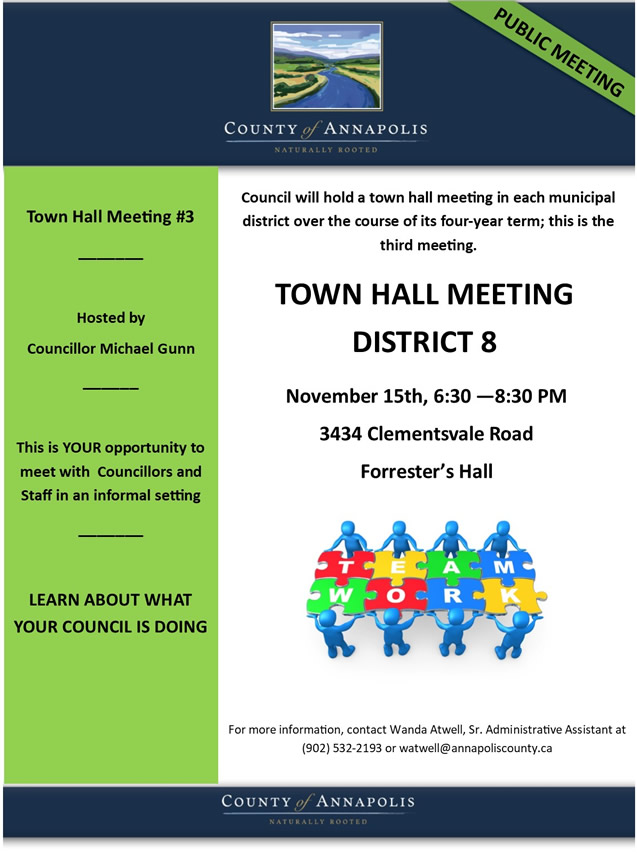
Town Hall Meeting District 3 and 7, 20-Sep-17
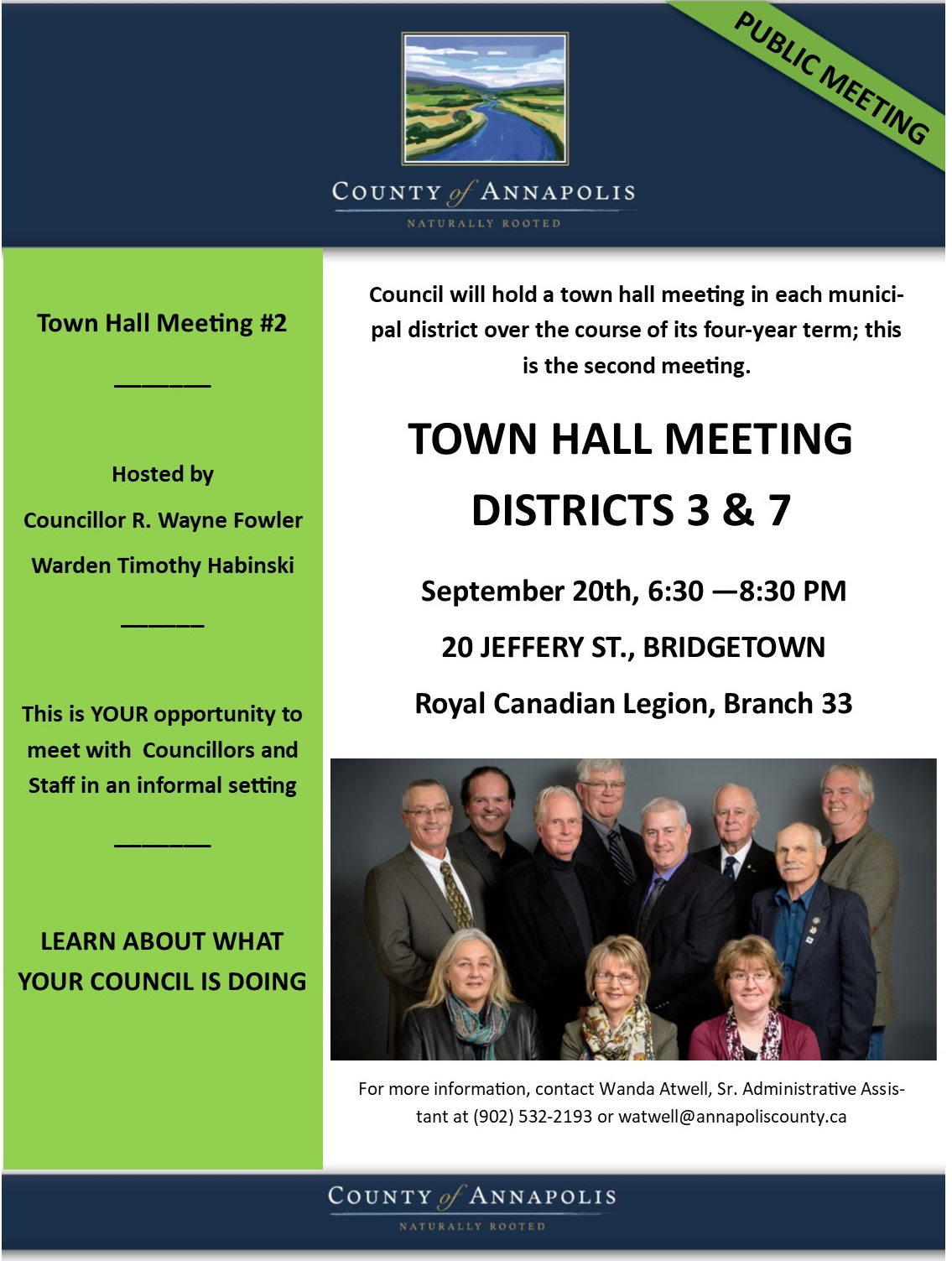
Town Hall Meeting -- District 2
